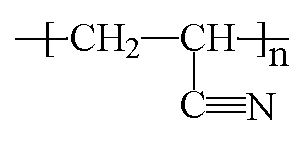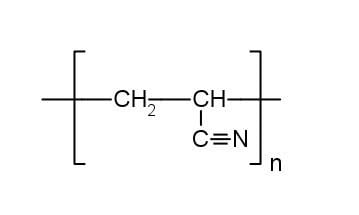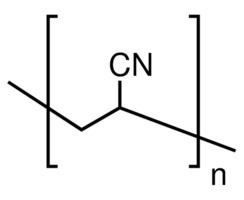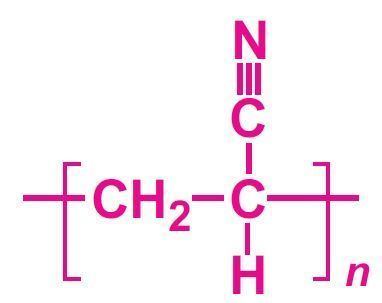 | ||
Similar Acrylonitrile, Polystyrene, Polypropylene | ||
Polyacrylonitrile (PAN), also known as Creslan 61, is a synthetic, semicrystalline organic polymer resin, with the linear formula (C3H3N)n. Though it is thermoplastic, it does not melt under normal conditions. It degrades before melting. It melts above 300 °C if the heating rates are 50 degrees per minute or above. Almost all polyacrylonitrile resins are copolymers made from mixtures of monomers with acrylonitrile as the main component. It is a versatile polymer used to produce large variety of products including ultra filtration membranes, hollow fibers for reverse osmosis, fibers for textiles, oxidized PAN fibers. PAN fibers are the chemical precursor of high-quality carbon fiber. PAN is first thermally oxidized in air at 230 degrees to form an oxidized PAN fiber and then carbonized above 1000 degrees in inert atmosphere to make carbon fibers found in a variety of both high-tech and common daily applications such as civil and military aircraft primary and secondary structures, missiles, solid propellant rocket motors, pressure vessels, fishing rods, tennis rackets, badminton rackets & high-tech bicycles. It is a component repeat unit in several important copolymers, such as styrene-acrylonitrile (SAN) and acrylonitrile butadiene styrene (ABS) plastic.
Contents
- Polyacrylonitrile
- History
- Synthesis
- Applications
- Oxidized Polyacrylonitrile Fiber OPF
- Carbon fiber
- References
Polyacrylonitrile
History
Polyacrylonitrile (PAN) was synthesized for the first time in 1930 by Dr. Hans Fikentscher und Dr. Claus Heuck in the Ludwigshafen works of then IG Farben. However as PAN is unfusible and not soluble in then common solvents the material was abandoned - similar as were the polymers of tetrafluoroethylene at Hoechst plant of IG Farben - and research was discontinued. It was not until 1931 when chemist Dr. Herbert Rein (1899-1955) in charge of polymer fiber chemistry at Bitterfeld plant of IG Farben obtained a sample of PAN while visiting the Ludwigshafen works. He did find pyridinium benzylchloride – an ionic liquid - would dissolve PAN. In 1942 Rein discovered an even better solvent for PAN dimethylformamide (DMF) and developed a technical process to process PAN to fibres and films. However war-time decline of infrastructure impeded commencing production. The first large scale production of PAN then branded as „Orlon“ was assumed by Du Pont in 1946 based on a patent filed exactly seven days after a nearly identical German claim (Ref. 7) was filed (sic!).
Synthesis

All commercial methods of production of PAN are based on free radical polymerization of Acrylonitrile (AN). Most of the cases, small amount of other vinyl comonomers are also used (1-10%) along with AN depending on the final application. Anionic polymerization also can be used for synthesizing PAN. For textile applications, molecular weight in the range of 40,000 to 70,000 is used. For producing carbon fiber higher molecular weight is desired.

In the production of carbon fibers containing 600 tex (6k) PAN tow, the linear Density of filaments is 0.12 tex and the filament diameter is 11.6 µm which produces a carbon fiber that has the filament strength of 417 kgf/mm2 and binder content of 38.6%. This data is demonstrated in the Indexes for Experimental Batches of PAN Precursor and Carbon Fibers Made from It table.
Applications

Homopolymers of polyacrylonitrile have been used as fibers in hot gas filtration systems, outdoor awnings, sails for yachts, and fiber-reinforced concrete. Copolymers containing polyacrylonitrile are often used as fibers to make knitted clothing like socks and sweaters, as well as outdoor products like tents and similar items. If the label of a piece of clothing says "acrylic", then it is made out of some copolymer of polyacrylonitrile. It was made into spun fiber at DuPont in 1942 and marketed under the name of Orlon. Acrylonitrile is commonly employed as a comonomer with styrene, e.g. acrylonitrile, styrene and acrylate plastics.

PAN absorbs many metal ions and aids the application of absorption materials. Polymers containing amidoxime groups can be used for the treatment of metals because of the polymers’ complex-forming capabilities with metal ions.

PAN has properties involving low density, thermal stability, high strength and modulus of elasticity. These unique properties have made PAN an essential polymer in high tech.

Its high tensile strength and tensile modulus are established by fiber sizing, coatings, production processes, and PAN's fiber chemistry. Its mechanical properties derived are important in composite structures for military and commercial aircraft.
Oxidized Polyacrylonitrile Fiber (OPF)
In addition to being a carbon fiber precursor, Oxidized PAN Fiber is also used to produce inherently flame resistant (FR) fabrics. Commonly when it is used in FR fabrics for protective apparel it is referred to as OPF (Oxidized Polyacrylonitrile Fiber) and is a high-performance & cost-effective flame and heat resistance solution. OPF can be considered one of the most FR fabrics commercially produced since it has an LOI (Limiting Oxygen Index) in the range of 45%-55% which is one of the highest LOI ranges available as compared with other common FR fabrics which have lower LOI values (e.g. Nomex @ 28%-30%, Kevlar @ 28%-30%, Modacyrlic @ 32%-34%, PBI @ 41%, and FR-Viscose @ 28%); and OPF also demonstrates the lowest toxic gas generation upon burning as compared with other common fabrics (e.g. Nomex, FR Polyester, and Cotton).
Oxidized Polyacrylonitrile Fiber is produced by solution spinning and then processing through a high temperature oven, in air, to stabilize the molecular structure.
Carbon fiber
Polyacrylonitrile is used as the precursor for 90% of carbon fiber production. Approximately 20-25% of Boeing and Airbus wide-body airframes are carbon fibers. However, applications are limited by PAN's high price of around $15/lb.
